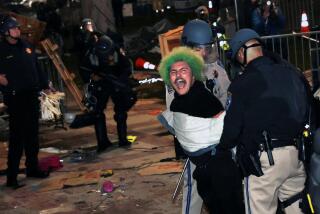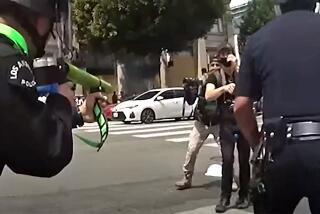Rubber Bullets Pass LAPD Test : Police: Officers used new ‘knee knockers’ to disperse crowd. Officials say the non-lethal munitions appear to be working well.
- Share via
In breaking up an unruly crowd this week at Florence and Normandie avenues, Los Angeles police fired rounds of foam rubber bullets, a new and relatively untested post-riot addition to the department’s formidable arsenal.
The new bullets, which are actually cylindrical projectiles resembling chunks of sausage, are intended to disperse crowds without causing serious injury. Officers fire a cartridge of projectiles from a .37-millimeter gas gun, aiming the weapon at the ground and allowing the rounds to ricochet into the crowd. Each cartridge contains five rounds about 1 5/8 inches long.
“It feels like being belted by a squash ball,” said Herbert Danner, national sales manager for Defense Technology Corp. of America, which manufactures the bullets. “They bounce up and hit the guys in the shins and knees. It gets their attention, and they get out of there.”
The rubber projectiles were approved for use by former Police Chief Daryl F. Gates shortly after the spring riots and have been enthusiastically embraced by Chief Willie L. Williams. The bullets had been under study since the beating last year of motorist Rodney G. King, when the department began to explore a variety of alternative weapons and munitions.
“They appear to be working very well for us,” said Sgt. H. G. Dublin of the department’s elite Metropolitan Division, the only officers authorized to carry the weapons. “We like what we see. It gives us a new option in crowd dispersal.”
The Monday afternoon incident at Florence and Normandie was the third since the April riots in which the rubber projectiles, also known as “knee knockers,” were fired at crowds in Los Angeles. The bullets were first used to break up a gang-related incident near USC on June 13 and again on July 4 at a gang-related gathering in southwest Los Angeles, police said.
No serious injuries were reported in any of the incidents, police said, and the crowds were dispersed without the use of more lethal firepower. In August in Maryland, however, a woman with osteoporosis died when a rubber bullet fired by a sheriff’s deputy broke her ribs and a bone splinter punctured her heart.
“There is always a danger to any of these tools, but the dangers are minimal when they are used properly,” said Cmdr. Rick Dinse, who oversees training for the LAPD. “There has been significant training for the people who use them.”
All 200 officers in the Metropolitan Division have been trained to fire rubber bullets, but typically only one or two officers in a squad of 12 carries one of the weapons when police approach an unruly crowd, Dinse said. The other officers carry batons, handguns and other traditional firearms.
Various versions of rubber bullets have been used to control crowds around the world, particularly in Israel, South Africa and Northern Ireland. Their use in the United States, however, has been limited, according to the nonprofit Police Foundation in Washington, D.C.
“It is an idea whose time has come,” said Hubert Williams, president of the law enforcement think tank. “We want to only use the degree of force that is required and no more. Non-lethal forms of force are a very positive addition to the array of options, and it is something that the LAPD should be complimented on.”
The Los Angeles County Sheriff’s Department has used rubber-style bullets for at least two years, but the bullets are slightly different from those used by the LAPD. The Sheriff’s Department trains field supervisors to fire projectiles of rubber and plastic from a .37-millimeter weapon, but the rounds are not fired at the ground.
Instead, according to Deputy Chris Braneulas, the projectiles are intended to “momentarily incapacitate” a suspect, in the same manner that a Taser gun temporarily stuns. Braneulas said the bullets have been used about a dozen times this year.
“We use it in circumstances where there needs to be some type of force used, where the person may be dangerous, or mentally disturbed or on narcotics, and we don’t want deputies to get too close with a baton,” said Braneulas, who trains deputies to use the weapon. “We feel it is a good weapon.”
In 1990, San Diego police also began using rubber bullets on a limited basis, and Danner said his firm has sold the munitions to a number of departments, including those in South Miami, Cleveland and Cincinnati and the FBI training academy.
“Every large police department in this country that thinks they are likely to have a riot situation have looked into these rounds or those of our competitors,” said Danner.
Hubert Williams, who was co-leader with William Webster of the special investigating panel into the riots, said use of the bullets by a high-profile department such as the LAPD will increase interest in the projectiles nationwide.
“What happened in South-Central this time around is widely viewed as an effective use of force and nipping the bud of a potential civil disorder,” he said. “Police departments will be studying it--all aspects of it.”
More to Read
Sign up for Essential California
The most important California stories and recommendations in your inbox every morning.
You may occasionally receive promotional content from the Los Angeles Times.










